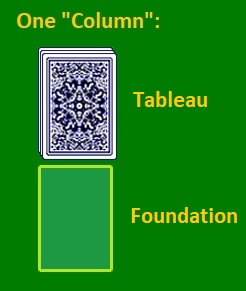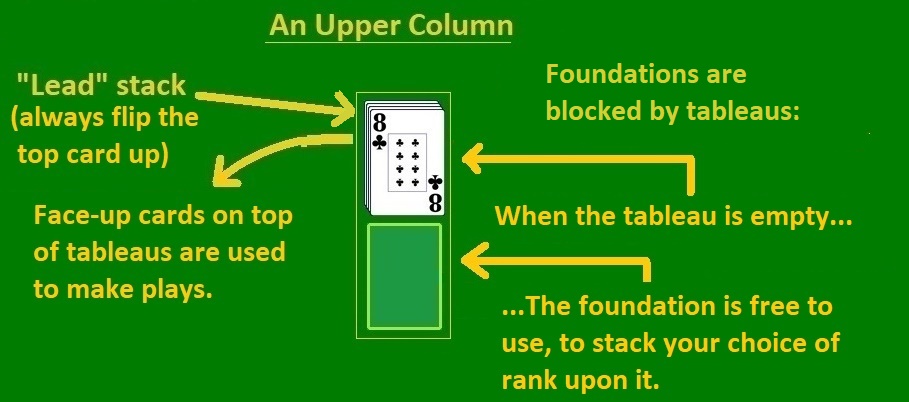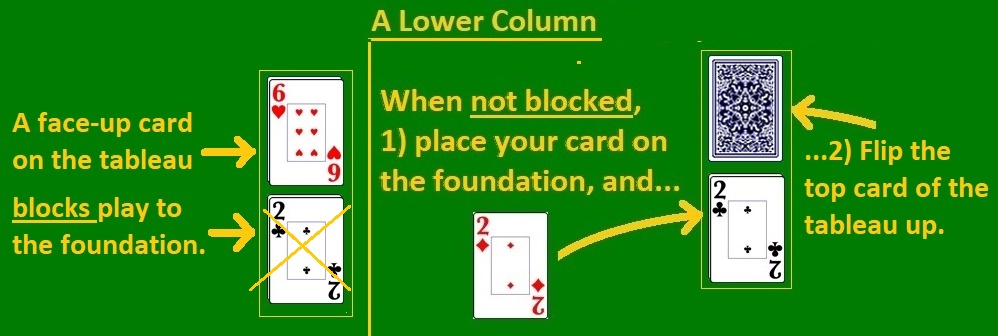Help Main |
|
||||
Intro 1: How to Play “Hopscotch”Our introduction to “Hopscotch” will use a deck of 27 cards, with 3 each of Aces and 2s through 9s.
|
|||||
|
Above: The cards are dealt face-down as 3 each on 9 tableaus. On an upper tableau, the top card is always flipped up. Right: A “column” is one tableau directly above one foundation. This game is comprised of 4 upper and 5 lower columns.
|
|
||||
|
Objective Your goal is to accumulate your choice of one rank, e.g. “Ace”, “2”, “3”, per foundation. At right is a picture of the above game at its end, with three-of-a-kind on each of 9 foundations: As we will see, all face-up cards on top of all tableaus are available for making plays, and for playing to any foundation on the board. Cards played to foundations are done moving for the rest of the game, and score one point each. If the upper tableaus are all cleared, then it is a “win”, and if all 27 points are scored, then it is a “perfect game”. Rule of Ascending Order Aces are low and Kings are high, and the player must “declare”, i.e. assign the ranks on the lowerwalk such that they ascend from left to right. As seen at right, on the upperwalk this is not required. |
|
||||
|
|
Side Note: This little game, called “Hop 45”, doesn't have royals; it stops at 9s, but Boardwalk includes larger games with more cards. There are number cards up to 15, and then Jacks, Queens, and Kings, and up to 5 suits of each. There are also three “wild ranks” which can be declared and stacked like the others, but wild ranks do not have to obey rules of ascending order. In my game descriptions, I state the highest numbered rank and the number of wild ranks, e.g. “9s, no wilds”.
|
|
|||
|
Making Plays Upper and lower columns each work their own way...
The “Slide Play”
|
|||||
|
Using the Software At right: I will mark out a play with my mouse, by selected a source card for the play, which will get an “S”, and then a destination, which will get a “D”. As marked at right, I have chosen to play a 9 to the rightmost lowerwalk foundation. Once marked, click “Play” or hit the “P” key to animate the play as marked, or right-click your mouse on the board to remove your markers and place them another way. If you want to see the same deal as above, you can copy and paste this dealcode in to get it: f3lnw6l61g3bi3k57dys8oqrt |
|
||||
|
Other Notes There is such a thing as a “spike”. Let us say that our 3rd Ace was dealt face-down at the bottom of the Aces tableau. That Ace is a spike because it will not cause itself to flip. When only spikes remain (face down), there will be no face-up cards on any tableaus, and so any spikes will be played out and scored for you. The particular game above, which is called “Hop 45”, plays quickly, and I think it plays fast and fun. This game is an example of the “Hopscotch class”, which simply means that it uses Hopscotch rules. Larger Hopscotch boards seem to play more slowly, and with a little more thought. With this software, you can create variations of these games. In the future, you can learn about using what is called a “hand”, which in the “Lucky” class can make plays to the lowerwalk, and in the “Scotsi” class can make plays to each of the walks. There are larger numbers of options with a hand. Even beyond this, there are more plays one can learn in the “Cheshire” class. Altogether, these games can range from 1-minute to 100-minute average playing times. Every Boardwalk game falls into a “weight class”. What this means is how hard the game is to win on average. A “featherweight” game means it can be won 99% of the time. A “heavyweight” game can be won maybe a third of the time. Hop 45 is a lightweight game, and this is common among the predefined games in the software. A player can also distinguish themselves by their scores in relation to others when playing the same deals. |
|||||
How To Play “Hopski” |
|||||
|
Hopski has all of the same rules as Hopscotch, with one change. In Hopski, the player must declare the ranks on each of the walks in ascending order, from left to right. As depicted in a perfect end game at right, each walk is in accordance. The game depicted is Hopski “47”, which is a featherweight type of game, with 4 upper and 7 lower columns, and 3 of each kind. This deck does not include 9s or 10s. There is also a heavier-weight Hopski “57”, which adds 9s for 12 ranks, and has 5 upper and 7 lower columns (36 cards total). |
|
||||
|
|
|||||








